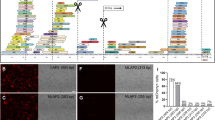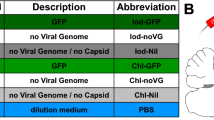Abstract
Recombinant AAV is increasingly becoming the vector of choice for many gene therapy applications in the CNS, due to its lack of toxicity and high level of sustained expression. With recent improvements in the generation of pure, high titer vector stocks, the regulation of gene expression is now a key issue for successful translation of gene therapy-based treatments to the clinic. The level of the transgene protein may need to be maintained within a narrow therapeutic window for the successful treatment of human disease. The doxycycline responsive system directs a dose-responsive, tightly regulated level of gene expression and has been used successfully in transgenic mouse models. Here, we have optimized an autoregulatory, bidirectional doxycyline responsive cassette specifically for use in rAAV. We minimized the size of the cassette and decreased the basal leakiness of the system, leading to tight regulation in the rat brain.
This is a preview of subscription content, access via your institution
Access options
Subscribe to this journal
Receive 12 print issues and online access
$259.00 per year
only $21.58 per issue
Buy this article
- Purchase on Springer Link
- Instant access to full article PDF
Prices may be subject to local taxes which are calculated during checkout








Similar content being viewed by others
References
Reed Clark K et al. Highly purified recombinant adeno-associated virus vectors are biologically active and free of detectable helper and wild-type viruses Hum Gene Ther 1999 10: 1031–1039
Monahan PE, Samulski RJ . AAV vectors: is clinical success on the horizon? Gene Therapy 2000 7: 24–30
Constantini LC, Bakowska JC, Breakfield XO, Isacson O . Gene therapy in the CNS Gene Therapy 2000 7: 93–109
Navarro V et al. Efficient gene transfer and long term expression in neurons using a recombinant adenovirus with a neuron specific promoter Gene Therapy 1999 6: 1884–1892
Peel AL, Klein RL . AAV vectors: activity and applications in the CNS J Neurosci Meth 2000 98: 85–104
Bjorklund A et al. Towards a neuroprotective gene therapy for Parkinson's disease: use of adenovirus, AAV and lentivirus vectors for gene transfer of GDNF to the nigrostriatal system in the rat Parkinson model Brain Res 2000 886: 82–98
Shen Y et al. Triple transduction with adeno-associated virus vectors expressing tyrosine hydroxylase aromatic-L-amino-acid decarboxylase and GTP cyclohydrolase I for gene therapy of Parkinson's disease Hum Gene Ther 2000 11: 1509–1519
During MJ et al. In vivo expression of the therapeutic human genes for dopamine production in the caudates of MPTP-treated monkeys using an AAV vector Gene Therapy 1998 5: 820–827
Rudich SM et al. Dose response to a single intramuscular injection of recombinant adeno-associated virus-erythropoetin in monkeys J Surg Res 2000 90: 102–108
Gossen M, Bujard H . Tight control of gene expression in mammalian cells by tetracycline-responsive promoters Proc Natl Acad Sci USA 1992 89: 5547–5551
Rivera VM et al. A humanized system for pharmacological control of gene expression Nat Med 1996 2: 1028–1032
Strathdee CA, McLeod MR, Hall JR . Efficient control of tetracycline-responsive gene expression from an autoregulated bidirectional expression vector Gene 1999 229: 21–29
Loeb JE et al. Enhanced expression of transgenes from adeno-associated vectors with the woodchuck post-transcriptional regulatory element: importance for gene therapy Hum Gene Ther 1999 10: 2295–2305
Flotte TR et al. Expression of the cystic fibrosis transmembrane conductance regulator from a novel adeno-associated virus promoter J Biol Chem 1993 268: 3781–3790
Bell AC, West AG, Felsenfeld G . The protein CTCF is required for the enhancer blocking activity of vertebrate insulators Cell 1999 98: 387–396
Gallia GL, Khalili K . Evaluation of an autoregulatory tetracycline regulated system Oncogene 1998 16: 1879–1884
Baron U, Gossen M, Bujard H . Tetracycline-controlled transcription in eukaryotes: novel transactivator with graded transactivation potential Nucleic Acids Res 1997 25: 2723–2729
Baron U, Gossen M, Bujard H . Tetracycline-controlled transcription in eukaryotes: novel transactivator with graded transactivation potential
Mastakov MY et al. Combined injection of rAAV with mannitol enhances gene expression in the rat brain Mol Ther 2001 3: 225–232
Haberman RP, McCown TJ, Samulski RJ . Inducible long-term expression in brain with adeno-associated virus gene transfer Gene Therapy 1998 5: 1604–1611
Bohl D, Salvetti A, Moullier P, Heard JM . Control of erythropoietin by doxycycline in mice after intramuscular injection of adeno-associated vector Blood 1998 92: 1512–1517
Freundlieb S, Schirra-Mueller C, Bujard H . A tetracycline controlled activation/repression system with increased potential in gene transfer into mammalian cells J Gen Med 1999 1: 4–12
Nakai H, Storm TA, Kay MA . Increasing the size of rAAV-mediated expression cassettes in vivo by intermolecular joining of two complementary vectors Nat Biotechnol 2000 18: 527–532
Duan D, Yue Y, Yan Z, Engelhardt JF . A new dual-vector approach to enhance recombinant adeno-associated virus-mediated gene expression through intermolecular cis activation Nat Med 2000 6: 595–598
Sun L, Li J, Xiao X . Overcoming adeno-associated virus vector size limitation through viral DNA heterodimerisation Nat Med 2000 6: 599–602
Kistner A et al. Doxycycline-mediated quantitative and tissue specific control of gene expression in transgenic mice Proc Natl Acad Sci USA 1996 93: 10933–10938
Acknowledgements
We thank R Bland, D Young and T Lawlor for critical reading of the manuscript. We are grateful to C Strathdee for providing the pBIG3r plasmid. This work was supported by the New Economy Research Fund, New Zealand Health Research Council, the National Institutes of Health and the Jefferson Faculty Foundation.
Author information
Authors and Affiliations
Rights and permissions
About this article
Cite this article
Fitzsimons, H., McKenzie, J. & During, M. Insulators coupled to a minimal bidirectional tet cassette for tight regulation of rAAV-mediated gene transfer in the mammalian brain. Gene Ther 8, 1675–1681 (2001). https://doi.org/10.1038/sj.gt.3301582
Received:
Accepted:
Published:
Issue Date:
DOI: https://doi.org/10.1038/sj.gt.3301582
Keywords
This article is cited by
-
SK3 Channel Overexpression in Mice Causes Hippocampal Shrinkage Associated with Cognitive Impairments
Molecular Neurobiology (2017)
-
RANGE: Gene Transfer of Reversibly Controlled Polycistronic Genes
Molecular Therapy - Nucleic Acids (2013)
-
Controlling brain tumor growth by intraventricular administration of an AAV vector encoding IFN-β
Cancer Gene Therapy (2009)
-
Recombinant AAV-mediated HSVtk gene transfer with direct intratumoral injections and Tet-On regulation for implanted human breast cancer
BMC Cancer (2006)
-
Current status of transcriptional regulation systems
Cytotechnology (2006)



